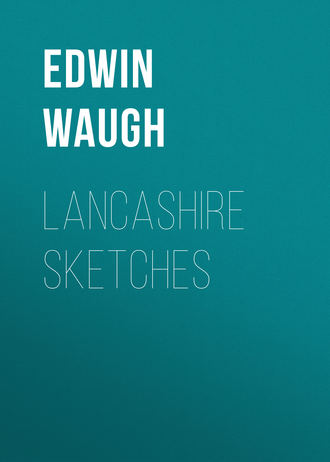 полная версия
полная версияLancashire Sketches
10
Pullen—poultry.
11
Hadloont reean—headland gutter.
12
Het—hight, called
13
Whewt—whistle.
14
This date is according to the 'Old Style,' which was then in use.
15
Old style.
16
Testa de Neville.
17
Harl. MSS. Codex 2,085, fo. 443.
18
Hard. MSS., 1296. There is a pedigree of this family in Dodsworth's MSS Bodleian Lib. vol. lxxix.
19
The "picking rod" is a straight wooden handle, by which the hand-loom weaver used to impel his shuttle. "As straight as a pickin' rod," is a common phrase among country people in South Lancashire.
20
"Radcliffe's Origin of Power-loom Weaving," pp. 59—66.
21
The village of Newton, on Newton Heath, near Manchester.
22
A kind of spiced cake, for which the village of Eccles, near Manchester, is famous.
23
A quaint old vendor of nuts and Eccles cakes, who used to be well known at Lancashire wakes and fairs.
24
Much valuable silver plate is sometimes lent by the inhabitants of Lancashire villages, to adorn the front of their native rush-cart during its annual peregrinations.
25
A thirty-six gallon barrel.
26
He was the landlord of an old road-side inn, on Newton Heath, with a pleasant bowling-green behind it. The house is still known as "Bill o' Booth's."
27
The following note is attached to this passage, in Mr. Gaskell's lectures:—"That noble master of language, Walter Savage Landor, who has done me the honour to refer to my lecture in the Examiner, says of this word 'symble,' a feast, it is very likely 'symbslum,' which means the same, in form of pic-nic; and adds, 'In Tuscany a fine cake is called semolino. When I was a boy at Rugby, I remember a man from Banbury who sold simnels, very eatable. The interior was not unlike mince-pie without fat, but flavoured with saffron; the exterior was hard, smooth, and yellow.'"
28
Harl. MSS. 1,926. There is a pedigree of this family in Dodsworth's MSS. Bodleian Lib. vol. lxxix.
29
Clarendon's "History of the Rebellion," edit. 1714, v. 1, p. 196.
30
Baines's 4to. "Hist. Lancashire," v. 1, p. 586: v. 2, p. 676. 12mo: v. 1, p. 55. Adams's Cat. of Lords, &c., who compounded for their estates, p. 51.
31
Survey of London, by Stowe, Strype's edition, 1720, vol 1, fol. 102.
32
Corry's Lancashire, v. 2, p. 619. In Dodsworth's MSS. Bodleian Lib. v. cxvii. p. 163, is a record of Robert Heywood, Esq.
33
Feeorin—fearful things.
34
Thomas Posthumus Holt, Esq., was one of the intended Knights of the Order of the Royal Oak. According to MS. memorandum, he died 26th March, 1669, "after sown-sett a hower, as they report it."—Burke's Commoners.
35
See "Tyrone's Bed," in Roby's "Traditions of Lancashire."
36
The turbulent Earl of Tyrone, who headed the Irish rebellion in the reign of Elizabeth.
37
Groo-weather—growing-weather.
38
Knowl hill, between Rochdale and Rossendale.
39
The dule steawnd theem 'at cut em deawn—the devil astonish those who cut them down.
40
Yers to mo, neaw?—hearest thou me, now?
41
Ir Jammy lad—our James's son.
42
Stoop—a stake; a long piece of pointed wood.
43
Marlock—a freak; a prank.
44
Delit—daylight.
45
Wilto, shalto—by force; against the will.
46
Scarrin—scaring; terrifying.
47
One of the Fenton family who own the land there.
48
Meyt-whol—meat-whole; able to eat his meals.
49
Aw'm so like—it may naturally be expected that I shall.
50
Folk at's a dur to keep oppen, connut do't wi'th wynt—folk that have a house to maintain, cannot do it with the wind.
51
Th' War Office—a name applied to the village of Bamford.
52
Hollingworth's Mancuniensis, Willis's edition, p. 53.
53
Court Magazine, vol. 8, No. 45.
54
Those somewhat remarkable posts have been removed of late years, and stout pillars of stone occupy their places.
55
Those oaks have been felled, and the kloof is now comparatively denuded of timber; the underwood on the left side is nearly swept away. Sad inroads on the ominous gloom of the place.
56
Kuerden's MS., fol. 274, Chetham Library.
57
Leland's "Itinerary" (Hearne's edit.), vol. vii. p. 42.
58
The following note is attached to this passage in Mr. Booker's volume:—"The annals of Blackley bear ample testimony to the superstition of its inhabitants. It has had its nine days' wonder at every period of its history. Hollingworth, writing of that age of portents and prodigies which succeeded the Reformation, says:—'In Blackley, neere Manchester, in one John Pendleton's ground, as one was reaping, the corne being cut seemed to bleede; drops fell out of it like to bloud; multitudes of people went to see it: and the straws thereof, though of a kindly colour without, were within reddish, and as it were bloudy!' Boggart-hole Clough, too, was another favourite haunt of ghostly visitants, the legend of which has been perpetuated by Mr. Roby in his "Traditions of Lancashire," vol. 2, pp. 295, 301. Nor has it ceased in our day: in 1852 one of its inhabitants imperilled the safety of his family and neighbours, by undermining the walls of his cottage, in his efforts to discover the hidden cause of some mysterious noise that had disturbed him."

